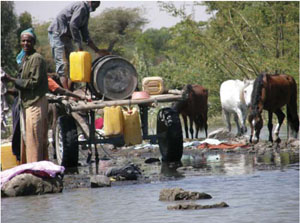Mixed epidemics
Mixed epidemics show characteristics of both common source and propagated epidemics. So a mixed epidemic can start with a common source and be followed by a propagated spread. Mixed epidemics are often caused by foodborne infectious agents.
Typhoid fever can easily spread and become a propagated epidemic. Can you remember from Study Session 33 how the typhoid bacteria are transmitted from person to person?
Typhoid bacteria are transmitted from infected people to new susceptible hosts via contaminated food or water.
The organism that causes typhoid (Salmonella typhi) can survive in sewage for 14 days and in water for up to seven days. Water polluted by faecal matter is therefore the main source of infection for typhoid. If the whole community drinks water from the same water source (Figure 42.3), which has been contaminated with Salmonella typhi, there will be a common source outbreak of typhoid fever. The epidemic may continue to spread through faecal matter passing from person to person, if the people in the affected community do not improve their standards of personal hygiene, or if the water is not treated and made safe to drink. This type of spread of typhoid is called a propagated epidemic of typhoid.
